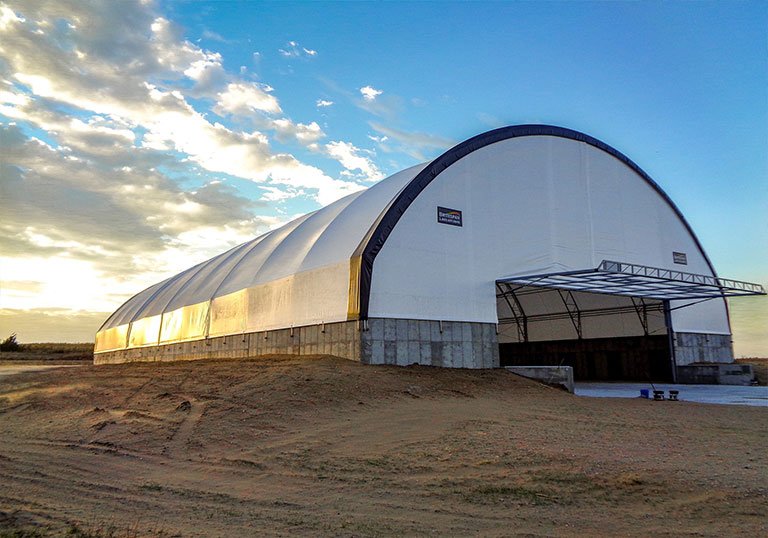use purpose of fabric building and hoopbarn
Views : 172
Update time : 2021-09-09
Purposes of Fabric Buildings and Hoop Barns:
Fabric Buildings:
Fabric buildings are versatile and used in a variety of industries and applications due to their flexibility, cost-effectiveness, and quick installation.
- Agriculture:
- Livestock Housing: Provide shelter for cattle, horses, poultry, and other animals.
- Crop Storage: Protect harvested crops such as hay, grain, and produce from the elements.
- Equipment Storage: Safeguard tractors, plows, and other agricultural machinery.
- Greenhouses: Create controlled environments for growing plants, flowers, and vegetables.
- Industrial:
- Warehousing: Temporary or permanent storage for raw materials, finished products, and inventory.
- Manufacturing: Provide space for production activities and assembly lines.
- Equipment Storage: House machinery, vehicles, and tools.
- Commercial:
- Event Venues: Host weddings, trade shows, concerts, and other large gatherings.
- Sports Facilities: Indoor arenas for sports like soccer, tennis, and equestrian events.
- Retail Spaces: Temporary or semi-permanent stores and showrooms.
- Residential:
- Garages: Protect cars, boats, RVs, and other vehicles.
- Workshops: Create spaces for hobbies, crafts, and small-scale manufacturing.
- Storage: Provide additional storage space for personal belongings and household items.
- Emergency and Humanitarian:
- Disaster Relief: Temporary shelters for displaced individuals and communities.
- Military Use: Rapid-deployment shelters for troops, equipment, and supplies.
- Medical Facilities: Field hospitals and clinics in remote or disaster-affected areas.
- Recreational:
- Campsites: Shelters for camping and outdoor activities.
- Sports: Covered spaces for activities like archery, gymnastics, and more.

Hoop Barns:
Hoop barns are a specific type of fabric building often used in agricultural and industrial applications due to their unique design and advantages.
- Agriculture:
- Livestock Housing: Provide economical and effective shelters for cattle, pigs, sheep, poultry, and other livestock. The open design ensures good ventilation, which is crucial for animal health.
- Feed and Grain Storage: Store animal feed, hay, and harvested grain, protecting them from the elements.
- Equipment Storage: House tractors, balers, and other farming equipment, keeping them secure and protected from weather damage.
- Composting: Used for composting facilities due to their ventilation and ease of access.
- Industrial:
- Storage: Store raw materials, finished products, and industrial equipment.
- Workshops: Create spaces for repairs, maintenance, and light manufacturing activities.
- Warehousing: Temporary or semi-permanent storage solutions for goods and inventory.
- Commercial:
- Event Spaces: Host trade shows, exhibitions, and other commercial events.
- Sports Facilities: Provide covered areas for sports training and events, such as equestrian centers, tennis courts, and soccer fields.
- Construction:
- Material Storage: Protect construction materials and equipment on-site.
- Workshops: Create on-site workspaces for construction activities and project management.
- Emergency and Humanitarian:
- Disaster Relief: Provide temporary shelters, storage, and operational bases for disaster response teams.
- Military Use: Serve as temporary barracks, equipment storage, and operational shelters for military operations.
Both fabric buildings and hoop barns offer a flexible, cost-effective solution for a wide range of needs, providing quick and adaptable structures for various applications.
Related News
 purpose of warehouse tent
purpose of warehouse tent
2021-09-09
Purpose of Warehouse Tents:
Warehouse tents, also known as temporary storage tents or fabric ware
 what is the fabric build made of and what is the advantage and disadvantage in compare of the classic building
what is the fabric build made of and what is the advantage and disadvantage in compare of the classic building
2021-09-09
what is the fabric build made of and what is the advantage and disadvantage in compare of the classi
 what is the size of fabric building, and what purpose of fabric building use for
what is the size of fabric building, and what purpose of fabric building use for
2021-09-09
what is the size of fabric building, and what purpose of fabric building use for
Sizes of Fabric Bui
 what standard size of container shelter and advantage of container shelter
what standard size of container shelter and advantage of container shelter
2021-09-09
what standard size of container shelter and advantage of container shelter
Standard Sizes of Contain
